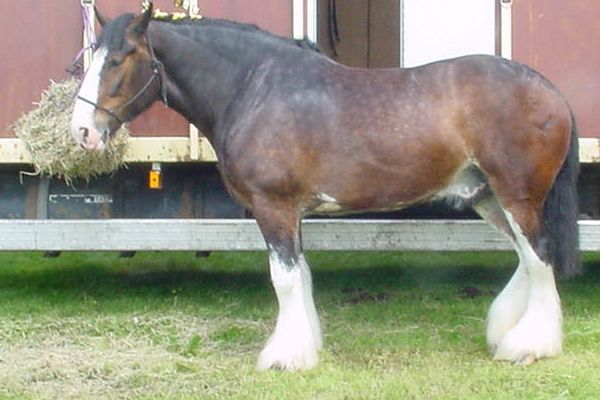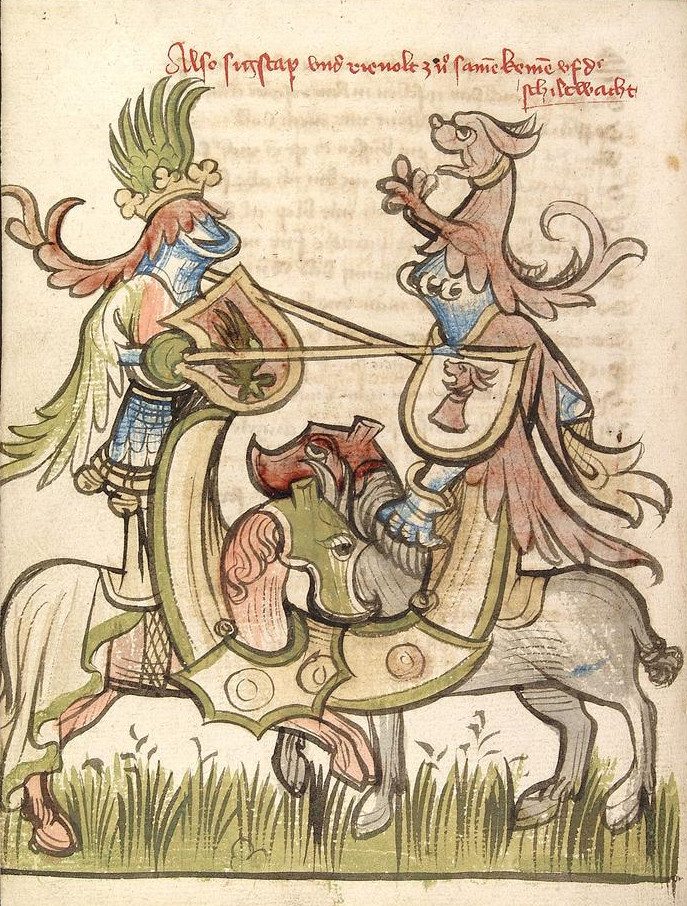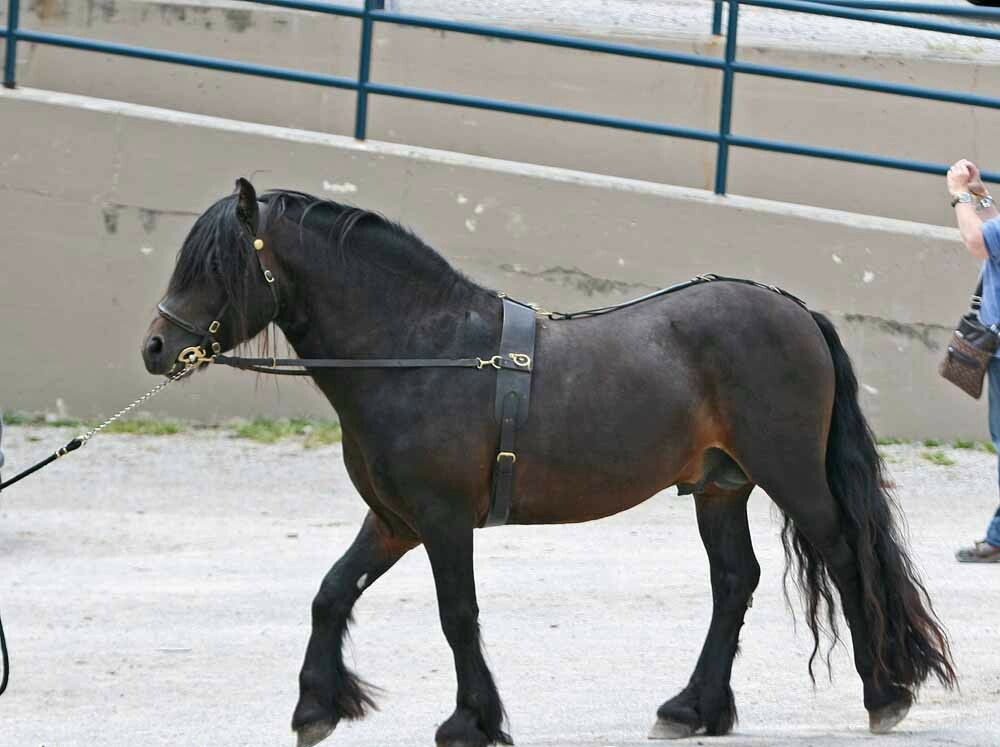|
Destrier
Mounted on a destrier, Richard Marshal unseats an opponent during a skirmish. The destrier is the best-known war horse of the Middle Ages. It carried knights in battles, tournaments, and jousts. It was described by contemporary sources as the ''Great Horse'', due to its significance. While highly prized by knights and men-at-arms, the destrier was not very common. Most knights and mounted men-at-arms rode other war horses, such as coursers and rounceys. The destrier is the ancestor of present breeds of baroque horses such as the Baroque pinto. Etymology The word is first attested in Middle English around 1330, as ''destrer''. It was borrowed into Middle English from Anglo-Norman ''destrer'', whose Old French counterpart was ''destrier'' (from which the Modern English spelling derives). The word is also found in medieval Provençal language, Provençal (as ''destrier'') and Italian (as ''destriere'', ''destriero''). These forms themselves derived from the Vulgar Latin ... [...More Info...] [...Related Items...] OR: [Wikipedia] [Google] [Baidu] |
Draft Horse
A draft horse (US) or draught horse (UK), also known as dray horse, carthorse, work horse or heavy horse, is a large horse bred to be a working animal hauling freight and doing heavy agricultural tasks such as plowing. There are a number of breeds, with varying characteristics, but all share common traits of strength, patience, and a docile temperament. While indispensable to generations of pre-industrial farmers, draft horses are used today for a multitude of purposes, including farming, draft horse showing, logging, recreation, and other uses. Draft breeds have been crossbred with light riding breeds such as the Thoroughbred to create sport horses or warmbloods. While most draft horses are used for driving, they can be ridden and some of the lighter draft breeds are capable performers under saddle. Characteristics Draft horses are recognizable by their extremely muscular build. They tend to have broad, short backs with powerful hindquarters. In general, they are t ... [...More Info...] [...Related Items...] OR: [Wikipedia] [Google] [Baidu] |
Baroque Horse
The term baroque horse describes a group of horse breeds, usually descended from and retaining the distinctive characteristics of a particular type of horse that rose to prominence in Europe during the Baroque era, after significant development throughout the Middle Ages. It describes the type of agile but strong-bodied descendants of horses in the Middle Ages such as the destrier. Specific ancestors of this type include the Neapolitan horse, and the Iberian horse of Barb ancestor known in the Middle Ages as the Spanish Jennet. They are characterized by powerful hindquarters, a muscular, arched neck, a straight or slightly convex profile, and usually a full, thick mane and tail. These horses are particularly well suited for the '' haute ecole'' discipline of classical dressage. Assorted crossbreds developed from these breeds also may attain breed status over time as they develop a breed registry and other indicia of purebred status. Historically, the destrier was a war horse ... [...More Info...] [...Related Items...] OR: [Wikipedia] [Google] [Baidu] |
Knight
A knight is a person granted an honorary title of a knighthood by a head of state (including the pope) or representative for service to the monarch, the church, or the country, especially in a military capacity. The concept of a knighthood may have been inspired by the ancient Greek '' hippeis'' (ἱππεῖς) and Roman ''equites''. In the Early Middle Ages in Western Christian Europe, knighthoods were conferred upon mounted warriors. During the High Middle Ages, a knighthood was considered a class of petty nobility. By the Late Middle Ages, the rank had become associated with the ideals of chivalry, a code of conduct for the perfect courtly Christian warrior. Often, a knight was a vassal who served as an elite fighter or a bodyguard for a lord, with payment in the form of land holdings. The lords trusted the knights, who were skilled in battle on horseback. In the Middle Ages, a knighthood was closely linked with horsemanship (and especially the joust) from its orig ... [...More Info...] [...Related Items...] OR: [Wikipedia] [Google] [Baidu] |
Joust
Jousting is a medieval and renaissance martial game or hastilude between two combatants either on horse or on foot. The joust became an iconic characteristic of the knight in Romantic medievalism. The term is derived from Old French , ultimately from Latin">-4; we might wonder whether there's a point at which it's appropriate to talk of the beginnings of French, that is, when it wa ... , ultimately from Latin "to approach, to meet". The word was loaned into Middle English around 1300, when jousting was a very popular sport among the Anglo-Normans, Anglo-Norman knighthood. The synonym tilt (as in tilting at windmills) dates . Jousting on horse is based on the military use of the lance by heavy cavalry. It transformed into a specialized sport during the Late Middle Ages, and remained popular with the nobility in England and Wales, Germany and other parts of Europe throughout the whole of the 16th century (while in France, it was discontinued after the death of King Henry II ... [...More Info...] [...Related Items...] OR: [Wikipedia] [Google] [Baidu] |
Man-at-arms
A man-at-arms was a soldier of the High Medieval to Renaissance periods who was typically well-versed in the use of arms and served as a fully-armoured heavy cavalryman. A man-at-arms could be a knight, or other nobleman, a member of a knight's or nobleman's retinue, or a mercenary in a company serving under a captain. Such men could serve for pay or through a feudal obligation. The terms ''knight'' and ''man-at-arms'' are often used interchangeably, but while all knights equipped for war were men-at-arms, not all men-at-arms were knights. Terminology Though in English the term man-at-arms is a fairly straightforward rendering of the French ''homme d'armes'', in the Middle Ages, there were numerous terms for this type of soldier, referring to the type of arms he would be expected to provide: In France, he might be known as a ''lance'' or '' glaive'', while in Germany, ''Spieß'', '' Helm'' or ''Gleve'', and in various places, a '' bascinet''. In Italy, the term '' barbut ... [...More Info...] [...Related Items...] OR: [Wikipedia] [Google] [Baidu] |
List Of Horse Breeds
The following list of horse and pony horse breed, breeds includes standardized breeds, some strains within breeds that are considered distinct populations, types of horses with common characteristics that are not necessarily standardized breeds but are sometimes described as such, and terms that describe groupings of several breeds with similar characteristics. While there is no single definition of the term "breed", it can be defined as a population sharing common ancestry, which has been subjected to similar selection objectives, and which conforms to certain established “breed standards”. Its members may be called ''purebred''. In most cases, bloodlines of horse breeds are recorded with a breed registry. The concept is somewhat flexible in horses, as open stud books are created for recording pedigrees of horse breeds that are not yet fully true-breeding. Registries are considered the authority as to whether a given breed is listed as a "horse" or a "pony". There are also a ... [...More Info...] [...Related Items...] OR: [Wikipedia] [Google] [Baidu] |
Christopher Gravett
Christopher Gravett is an assistant curator of armour at the Tower Armouries specialising in the arms and armour of the medieval world. Gravett has written a number of books and acts as an advisor for film and television projects. Selected works * (1985) ''German Medieval Armies, 1300-1500'', Osprey Publishing, * (1993) ''The Norman Knight, 950-1204 AD'', Osprey Publishing, * (1997) ''Medieval German Armies, 1000-1300'', Osprey Publishing, * (1999) ''Bosworth 1485: Last Charge of the Plantagenets'', Osprey Publishing, * (2000) ''Hastings 1066'', Osprey Publishing, * (2001) ''The History of Castles: Fortifications Around the World'', Lyons Press, * (2002) ''English Medieval Knight 1300-1400'', Osprey Publishing, * (2002) ''English Medieval Knight 1200-1300'', Osprey Publishing, * (2003) ''Towton 1461: England's Bloodiest Battle'', Osprey Publishing, * (2003) ''Tewkesbury 1471: The Last Yorkist Victory'', Osprey Publishing, * (2003) ''Norman Stone Castles: British Isles 1 ... [...More Info...] [...Related Items...] OR: [Wikipedia] [Google] [Baidu] |
Stallion
A stallion is an adult male horse that has not been gelded ( castrated). Stallions follow the conformation and phenotype of their breed, but within that standard, the presence of hormones such as testosterone may give stallions a thicker, "cresty" neck, as well as a somewhat more muscular physique as compared to female horses, known as ''mares'', and castrated males, called ''geldings''. Temperament varies widely based on genetics and training, but because of their instincts as herd animals, they may be prone to aggressive behavior, particularly toward other stallions, and thus require careful management by knowledgeable handlers. With proper training and management, stallions are effective equine athletes at the highest levels of many disciplines, including horse racing, horse shows, and international Olympic competition. "Stallion" is also used to refer to males of other equids, including zebras and donkeys. Herd behavior Young female horses usually leave their band ... [...More Info...] [...Related Items...] OR: [Wikipedia] [Google] [Baidu] |
Medieval Warfare
Medieval warfare is the warfare of the Middle Ages. Technological, cultural, and social advancements had forced a severe transformation in the character of warfare from antiquity, changing military tactics and the role of cavalry and artillery (see military history). In terms of fortification, the Middle Ages saw the emergence of the castle in Europe, which then spread to the Holy Land (modern day Israel and Palestine). Organization The medieval knight was usually a mounted and armoured soldier, often connected with nobility or royalty, although (especially in north-eastern Europe) knights could also come from the lower classes, and could even be enslaved persons. The cost of their armour, horses, and weapons was great; this, among other things, helped gradually transform the knight, at least in western Europe, into a distinct social class separate from other warriors. During the crusades, holy orders of Knights fought in the Holy Land (see Knights Templar, the Hospitalle ... [...More Info...] [...Related Items...] OR: [Wikipedia] [Google] [Baidu] |
Packhorse
A packhorse, pack horse, or sumpter refers to a horse, mule, donkey, or pony used to carry goods on its back, usually in sidebags or panniers. Typically packhorses are used to cross difficult terrain, where the absence of roads prevents the use of wheeled vehicles. Use of packhorses dates from the Neolithic period to the present day. Today, westernized nations primarily use packhorses for recreational pursuits, but they are still an important part of everyday transportation of goods throughout much of the developing world and have some military uses in rugged regions. History Packhorses have been used since the earliest period of domestication of the horse. They were invaluable throughout antiquity, through the Horses in the Middle Ages, Middle Ages, and into modern times where roads are nonexistent or poorly maintained. Historic use in England Packhorses were heavily used to transport goods and minerals in England from medieval times until the construction of the first toll ro ... [...More Info...] [...Related Items...] OR: [Wikipedia] [Google] [Baidu] |
Palfrey
A palfrey is a type of horse that was highly valued as a Horses in the Middle Ages, riding horse in the Middle Ages. It was a lighter-weight horse, usually a smooth horse gait, gaited one that could ambling, amble, suitable for riding over long distances. Palfreys were not a specific breed as horse breeds are understood today. Etymology The word "palfrey" is cognate with of any type); both words descend from , itself deriving from Gaulish . Meanwhile, the German term for a palfrey is (), cognate with Icelandic (language), Icelandic . Breeding A palfrey usually was the most expensive and highly bred type of riding horse during the Middle Ages, sometimes equalling the knight's destrier in price. Consequently, it was popular with nobles, ladies, and highly ranked knights for riding, medieval hunting, hunting, and ceremonial use.Ewart Oakeshott, Oakeshott, Ewart. ''A Knight and his Horse'', Rev. 2nd Ed. USA:Dufour Editions, 1998. Knights would ride palfreys to battle so th ... [...More Info...] [...Related Items...] OR: [Wikipedia] [Google] [Baidu] |







